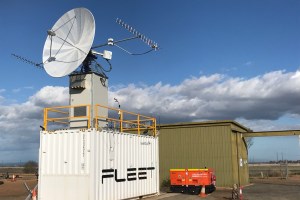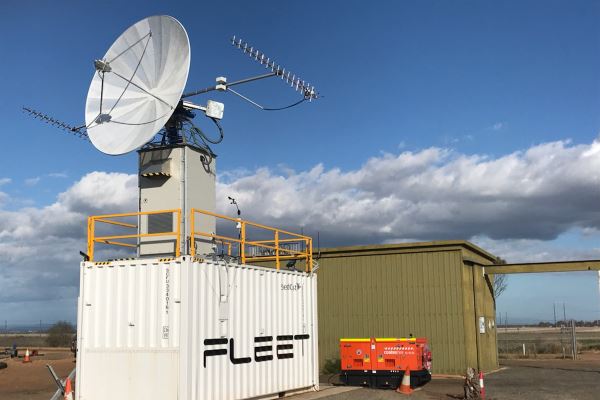Fleet Space Technologies has opened a commercial tracking station to track and transmit data from nanosatellites in the Internet of Things global network.
The ground station, opened today at Pinkerton Plains, 80km north of Adelaide, completes the mission control centre built at Fleet’s headquarters in South Australia’s capital.
Fleet plans to link up the Internet of Things with its satellites and LoRaWAN™ hub technology.
Fleet CEO Flavia Tata Nardini said the ground station would allow space startups across Australia and the world to monitor their own nanosatellites and payloads at a fraction of the cost of larger operators.
She said it was the first piece of commercial space infrastructure built in Australia since the Federal Government announced earlier in the year it would create a national space agency.
“The ground station will break barriers for space startups locally and abroad, creating opportunities that were previously only available to large organisations,” said Nardini.
“We’re democratising space and advancing global collaboration.
“We knew it was ambitious to build and operate a world-class ground station in less than six months. It’s a huge achievement for a small startup to receive leasing rights, let alone build a fully functioning mission control centre within this short timeframe.
Delivering world class service
The mission control centre will track Fleet’s first two nanosatellites – Centauri I and II – that will launch later this year aboard Indian Space Agency and SpaceX rockets after Fleet received its Overseas Launch Certificate (OLC) under the Australian Space Activities Act this week.
“We’re proud that we can start working on this – owning and operating a ground station in Australia is a key part of ensuring we can deliver world class service with our satellites for our customers,” said Nardini.
“The ground station launch cements our commitment to driving quicker access to data to help transform billion-dollar industries, from precision agriculture on isolated rural farms in Tasmania, maritime monitoring in the middle of the Pacific Ocean and food supply chain management in Asia.
The ground station, below, and mission control centre have been built in collaboration with Italian satellite ground segment service provider Leaf Space, which engineered and supplied a turn key satellite dish integrated with monitoring and control systems critical to receiving radio waves from nanosatellites orbiting Earth.
Enormous demand
The 3m dish has two frequencies and is part of the first ground station built by the Italian company outside of Europe. The autonomous ground station will be operated from the mission control centre in Adelaide and Italy.
“The proliferation of nanosatellites in recent years has created enormous demand for new ground stations across the globe for tracking, uplink and downlink operations,” said Giovanni Pandolfi, co-founder and Chief Technical Officer of Leaf Space.
“South Australia is emerging as a space hub with ambitious startups, incredible talent and innovative technologies, we’re pleased to extend our installation of ground stations to Australia and increase operational efficiency for local and international satellite operators.”
The South Australian Government is pursuing the downstream space segment, looking to develop activities that employ data and knowledge that are derived from the space for Earth-related objectives.
Special day for South Australia
South Australian Premier Steven Marshall is also the state’s Minister for Space Industries.
“It’s a very special day for South Australia and in fact the whole country as we move to the establishment of the National Space Agency,” he said.
A report released by the South Australian Space Industry Centre (SASIC) has determined that almost 1.5 million Australian companies need these space-derived applications.
SASIC director Nicola Sasanelli said South Australian companies like Fleet Space Technologies and Myriota were examples of businesses driving the downstream sector.
Myriota, a spinoff technology company from the University of South Australia, this year raised $15 million to further its IoT network of sensors, attracting investment from Boeing.
“South Australia is involved in this fantastic journey to the knowledge economy and space activities are very important to this,” Sasanelli said.
Sasanelli said Morgan Stanley expected the space economy to hit US$1.1 trillion by 2040, while Bank of America Merrill Lynch estimated it would grow eight-fold in the next 30 years, reaching US$2.7 trillion in 2045.
More than 800 jobs
“At the moment we (Australia) take 0.8 per cent of the (US)$300 billion global space economy that is growing at 9 per cent a year, so there is still an opportunity for us to be active in this area,” he said.
“Other countries with space agencies, like Canada, manage $500 million per year and they are part of the big, global program.
“It’s an ambition for our industries and our research centres to be involved in these global programs.”
Sasanelli said South Australia had 30 organisations involved in the space industry just 12 months ago.
“Now it is 60, with more than 800 jobs in these South Australian organisations,” he said.
“Growing Australia’s space industry to realise its full potential will take a truly national approach and this is something which South Australia has consistently worked towards.”
Head of the new Australian Space Agency Dr Megan Clark AC said Fleet’s ground station was an example of some of the great space-related activities underway in Australia.
Jim Plouffe is a senior writer with The Lead, South Australia


